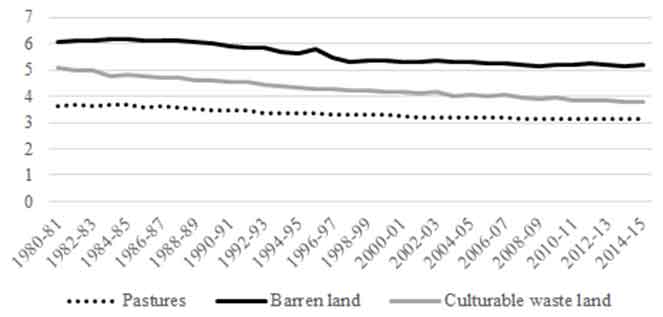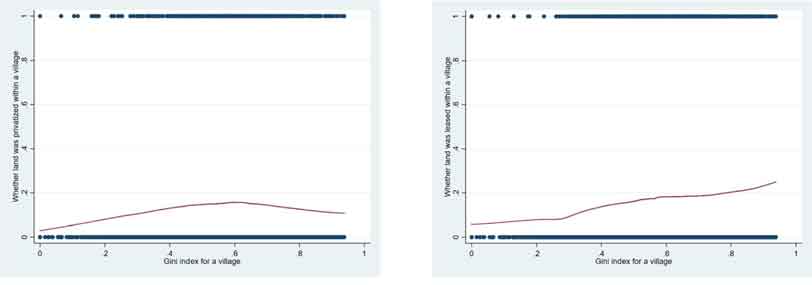The area under common pool land resources (CPLRs), which are crucial to rural livelihoods in India, has recorded a steady decline over the last three decades. Common land is diverted either as private household assets within a village or assigned for long-term lease to individuals or corporates from outside the village. This article analyses nationally representative data to explore the relationship between economic inequality and the likelihood of such diversion of CPLRs.
Lands that are commonly managed and accessed by communities – such as village forests, community pastures, community threshing floors, and barren lands – are termed as common property land resources (CPLRs).1 These lands provide fodder, firewood, and several non-timber forest products (including fibre, bamboo, medicinal herbs, oils, resin, gum, and honey) for consumption and sale in rural India. The average dependence on CPLRs is estimated to be 3% of rural household consumption expenditure (National Sample Survey Organisation (NSSO), 1999), with several micro-studies reporting contributions in the range of 12-23% of household incomes of the rural poor (Beck and Ghosh 2000, Iyengar 1989, Jodha 1986).
Loss of commons
A steady decline in area under CPLRs has been recorded in the country over the last three decades. Using reclassification of land-use statistics, Chopra (2002) assessed area under CPLRs to be 21.6% of India’s total geographical area in 1980-81. This area reduced to 15% of total geographical area, with losses ranging between 1-32% across various districts (NSSO, 1999). Statistics for three classifications2 of land that qualify as CPLRs, highlight the continued loss of commons. Pastures and grazing land, barren land, and culturable wasteland were 3.6%, 6.1%, and 5.1%, respectively, of India’s total geographical area in 1980, and reduced to 3.1%, 5.2%, and 3.8%, respectively, in 2015 (Figure 1).3 Given the nature and extent of dependence of rural population on CPLRs in India, such erosion of CPLRs has severe implications for rural livelihood strategies.
Figure 1. Percentage of geographical area under various land-use classifications that qualify as CPLRs: 1980-2015
 Source: All India land use classification data; Directorate of Economics and Statistics, Ministry of Agriculture and Farmers Welfare
Source: All India land use classification data; Directorate of Economics and Statistics, Ministry of Agriculture and Farmers Welfare
Why inequality matters
CPLRs are characterised by multiple – often overlapping – property rights and ambiguities in legal frameworks and formal land-use classifications (Lele et al. 2013). This results in physical boundaries of CPLRs being continually subjected to contested priorities of various stakeholders. Subsequent loss can be an outcome of control exercised by local institutions (such as Panchayats and Village Forest Committees) within villages or by the State directly. In both cases, the diversion of CPLRs is determined by formal institutions and informal norms, which, in turn, are influenced by socioeconomic contexts faced by the actors.
Within a village, loss of CPLRs is recorded when encroachments by households on common lands are legalised by local institutions.4 It is well documented that elites often dominate the decision-making processes of formal village-level institutions as well as informal rules designed for cooperative sharing of natural resources. Such capture of local institutions is likely to reduce the ex-ante costs of social legitimisation and subsequent legalisation of encroached land by the elite. However, loss of CPLRs may not always be the preferred outcome for elites as they depend on the resources extracted as well. In fact, few instances of appropriation of CPLRs by disadvantaged sections have been reported (Yanagisawa 2008, Bokil 1996). Underlying power relations within relevant local institutions that can aid such legalisation include non-agricultural job and urban migration opportunities, State-mandated affirmative policies for representation of backward groups in formal institutions, and political mobilisation.
The outcome of State intervention is typically long-term leases of CPLRs to entities not belonging to the village. The State might seek to divert CPLRs away from being commonly managed and accessed to aid its developmental agenda (including for distributional or efficiency gains, such as policies for land redistribution to disadvantaged groups), introduction or augmentation of existing industrial set-up, infrastructure development, public utilities, conservation of biodiversity,5 or to appropriate rent.6 Any of these agendas reflect the State’s mandate to develop poorer regions. However, political resistance to land diversion is expected to be lower in regions with high economic inequality. In fact, it has been documented that state officials often align with market actors to facilitate privatisation of CPLRs (Grafton 2000).
Causal impact of economic inequality on loss of CPLRs
We use the NSSO survey of 1998 on CPLRs in India to establish the causal impact of economic inequality on loss of CPLRs (Thapliyal et al. 2019). This was the first, and so far only, nationally representative survey that provides detailed information on all types of CPLRs in India. A total of 78,990 households were interviewed from 5,115 Census villages across 25 states and seven union territories. The survey consists of two schedules pertaining to CPLRs – the village-level schedule (including detailed information on de jure and de facto rights to access CPLRs) and the household-level schedule (including socioeconomic household characteristics and extent of dependence on CPLRs). Data from these two schedules were merged at the village level to construct our sample of 4,621 villages. In addition to these household- and village-specific characteristics, we also account for social and gender inequalities as well as key district-level characteristics that may influence CPLRs (including historical land rights, rainfall, and agro-climatic zones). Approximately 13% of the villages lost CPLRs to village-level privatisation and 17% of the villages reported long-term lease of land by the State. Preliminary plots show that economic inequality (measured using Gini index based on dispersion of households’ land holding)7 has a non-monotonic8 relationship with privatisation of CPLRs (Figure 2, left panel) and a positive relationship with land leased (Figure 2, right panel).
Figure 2. Relationship between economic inequality and two types of privatisations: local privatisation (left panel) and State-led lease (right panel)
 Note: Authors’ calculations based on the merged household and village-level data (NSSO, 1998).
Note: Authors’ calculations based on the merged household and village-level data (NSSO, 1998).
We account for several household and village characteristics including social heterogeneity and agro-climatic zones in our empirical analysis. Nonetheless, there is potential ‘reverse causality’ in the relationship between economic inequality and loss of CPLRs: loss of CPLRs can exacerbate inequality as the poor depend on them heavily. To address this concern, we use the instrumental variable9 approach. Following Markussen (2011), we use the proportion of female and male agricultural cultivators as a share of total working female and male population, respectively, in the rural sector (1991 Census data) as instruments for economic inequality.10 These proportions are good proxies for economic inequality but are not expected to directly result in loss of CPLRs.
At lower levels of economic inequality (till the identified inflection point of Gini index = 0.62), a percentage point increase in inequality increases the likelihood of privatisation of commons by 34 percentage points. Beyond this threshold, a percentage point increase in inequality reduces the likelihood of commons’ privatisation by 27.4 percentage points. The impact of land-based inequality is positive on state-led lease – a percentage point increase in the inequality results in an increased likelihood of land being leased out by 15.6 percentage points within villages. This impact is dampened by state and agro-climatic zones fixed effects.
Policy implications
Policy decisions at different tiers of governance call for careful consideration of economic inequality. Community-level institutions such as Gram Panchayats and Village Forest Committees should be empowered – especially in regions with high inequality – to manage usufruct11 rights particularly under programmes of social forestry and joint forest management. This will ensure continued contribution of the CPLRs to livelihood strategies of the rural poor. The state must, however, carefully weigh the purpose for which common land is being diverted. Long-term leases must provide the necessary stimuli (direct or indirect) to the rural economy. Furthermore, policy regarding land use must pay attention to all forms of CPLRs.
I4I is now on Telegram. Please click here (@Ideas4India) to subscribe to our channel for quick updates on our content
Notes:
- The ownership of these lands usually rests with either the Forest Department or the Revenue Department of the state.
- Land-use statistics in India are based on a nine-fold classification and is available at https://aps.dac.gov.in/LUS/Index.htm.
- Several state-level studies report loss of CPLRs to be between 20-50%. In his study of 21 districts across seven states of western and southern India, Jodha (1989) observed a decline ranging from 26% to 54% in CPLRs between 1950s and 1980s. Pasha (1992) noted a loss of 36% to 24% in area under commons in Karnataka between 1970 and 1990. Salman (2013) reported that CPLRs were 34.38% of the land in Uttar Pradesh in 1950-51, which declined to 14.3% in 2005, with the loss in area for the last decade of the assessment period reported to be 20,765 hectares.
- Interestingly, concurrent with the loss of commons, satellite data between 2000 and 2017 indicated an increase in vegetation in India primarily driven by increasedarea under cultivation (Chen et al. 2019).
- Scholars have recently argued that increased forest cover in India is also attributable to commons land being converted to protected areas (Kashwan 2019).
- Rents’ here refer to a surplus value (can also be thought of as supernormal profit) after accounting for costs and normal returns.
- The Gini index measures the extent to which the distribution of income (or, in some cases, consumption expenditure) among individuals or households within an economy deviates from a perfectly equal distribution.
- A non-monotonic sequence is a sequence where the successive values oscillate and do not continuously increase or decrease.
- Instrumental variables are used in regression analysis when the outcome and predictor of interest are determined simultaneously or when both are correlated with an omitted variable in the model. An instrument is a third variable used to identify the unobserved correlation, which allows us to see the true correlation between the predictor and outcome variable.
- High ratio of male and female cultivators working on their own farm indicates equitable distribution of land in the village, that is, low economic inequality.
- Usufruct is the legal right to use another individual’s property temporarily and to keep any profit made from it.
Courtesy : Deepak Malghan (Indian Institute of Management Bangalore) , Arnab Mukherji (Indian Institute of Management Bangalore) , Sneha Thapliyal (Indian Institute of Management Indore)


